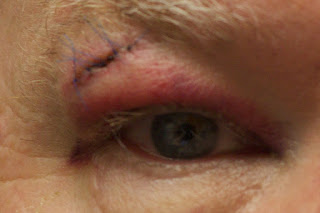 |
| Image Source: Flickr |
Author: Kaitlin Fries, DO
Doctors Hospital
Originally Published: Modern Resident February/March 2016
Eyelids are often one of the more complex locations for providers to perform laceration repairs. The eye has many important neighboring structures that can often be damaged by even minor trauma to the eye. As with any wound, it is important to start by doing a thorough exam of the tissue involved, being sure to assess for the possibility of a retained foreign body. Once the area has been evaluated it is time to ensure that a few critical nearby anatomical structures are still intact.
Lacrimal canaliculus and nasolacrimal duct: Injuries to the tear ducts will present with a large amount of tears running down the patients face.[2] Injury to these structures is typically seen with lacerations to the medial aspect of the lower lid.[2] If missed the patient can experience chronic eye tearing.[2]
Medial palpebral ligament: Patients who present with a “cross-eyed” appearance should be assessed for a laceration of the medial palpebral ligament.[2]
Levator palpebrae muscle: Injuries to this muscle most commonly present as traumatic ptosis, as the function of the levator is to hold the eye in its normal position while open.[2] Any laceration to the upper eyelid with periorbital fat extruding from it should raise suspicion for levator palpebrae injury.[2]
All of the injuries above, as well as those lacerations involving the inner surface of the eyelid, should be referred to an ophthalmologist for closure.[1,2] For all uncomplicated eyelid lacerations, it is recommended to use a single layer closure with 6-0 nonabsorbable suture.[1,2] Repairing lacerations that involve the lid margin requires very precise work to ensure the lid margins are properly aligned. Most texts recommend that this type of repair be referred to a consultant, such as plastic surgery.[1,2] There is no need to apply a dressing, as this is likely to cause more discomfort to the patient.
Eyebrow lacerations are typically simple and uncomplicated. It is not recommended to shave or trim the eyebrows.[2] Using 5-0 nonabsorbable suture, start by placing a few sutures to align the superior and inferior margins of the brow hair.[2] If necessary, next place a few deep sutures to approximate the superficial fascia.[2] Then finish the repair with a simple interrupted closure. Once again, no dressing is necessary. For all eyelid and eyebrow lacerations, patients are recommended to perform daily wound care by cleaning and applying antibiotic ointment. Suture removal is generally scheduled in three to five days.[1,2]
References:
1. Tintinalli J. Emergency wound management In: Tintinalli’s emergency medicine: Just the facts 2013: (3)54.
2. Trott A. Special anatomical sites In: Wounds and lacerations: Emergency care and closure 1997: (2): 86-189.
